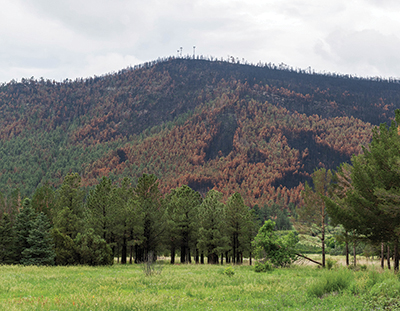NMSU’s John T. Harrington Forestry Research Center in Mora operates on a mission to advance the understanding of restoration activities on forested areas in New Mexico through multidisciplinary research, education and stakeholder collaborations.
But New Mexico’s largest wildfire nearly derailed that mission earlier this year.
In early May 2022, the Hermits Peak/Calf Canyon Fire breached the center’s densely forested property, imperiling the only facility in the Southwest dedicated to reforesting lands burned by catastrophic wildfires. By then, the fire had torched more than 200,000 acres and appeared on a path to destroy the center, plunging the center’s staff into a nightmare scenario.
“Our research center is primarily focused on restoring post-fire landscapes, and it is ironic that our facility and research is being threatened by a forest fire,” says Owen Burney, a forest regeneration scientist and director of the center since 2012.
Faced with evacuation orders and the threat of losing critical research, Burney led his staff into action. Their top priority was saving the center’s vast seed collection. They first relocated the bank of more than 3 million seeds to Las Vegas, but then had to move it more than 150 miles south to Los Lunas after the fire shifted toward San Miguel County. Next, they retrieved about 75,000 tree seedlings from the center’s nursery in a rescue operation carried out over two days with help from outside groups and a state police escort.
Although the center was spared from destruction, Burney and his staff are making up for lost time. The evacuation spanned about five weeks, but the toll is much greater.
“It sets us back at least a year, if not more,” Burney says. “We’ve lost opportunities to obtain good data from both field and lab measurements.”
In August 2022, the center relaunched several research projects placed on hiatus, including one on the Luna Fire burn scar near Chacon, New Mexico, which involves planting some of the rescued seedlings that survived a nearly 200-mile round trip from Mora to Santa Fe.
Burney explains the project is looking at different planting strategies and nursery techniques to improve planting success.
“For one portion of a study, we are limiting irrigation in order to stress seedlings in the nursery so that those trees are better adapted to the actual planting environment, which will be warm and dry,” he says.
The research will help inform management strategies for areas decimated by the Hermits Peak/Calf Canyon Fire, which had charred 341,735 acres by the time it was 100% contained in late August 2022, Burney says. He roughly estimates that 60,000 to 80,000 acres of the fire footprint will need to be replanted, a mammoth task requiring between 9 million to 20 million seedlings.
Overall, Burney says, reforestation needs in New Mexico are currently estimated to be between 1 million to 2.6 million acres, which would require 150 to 390 million seedlings. Each year, the center produces up to 300,000 seedlings, well below the needs of the state.
Burney says the Southwest needs a regional reforestation center, an initiative he’s been actively pushing for several years with collaborators from the University of New Mexico, New Mexico Highlands University and the New Mexico Energy, Minerals and Natural Resources Department’s Forestry Division.
The center would operate on a vision to bring forest management into the 21st century by significantly increasing reforestation capacity across the critical areas of seed collection, nursery production and planting.
“This would bring us up to 5 million seedlings per year and allow us to really address our backlog of reforestation needs,” Burney says. “We know we’re going to get more fires like this, and we need a nursery that allows us to restore those forests.”

In early May 2022, the Hermits Peak/Calf Canyon Fire breached the dense forest near NMSU's John T. Harrington Forestry Research Center in Mora, New Mexico, threatening several research projects.

Dove Hall, Room 212
305 N. Horseshoe Drive
Las Cruces, NM 88003